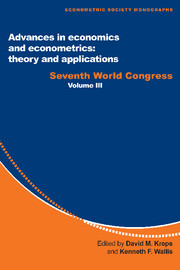Book contents
- Frontmatter
- 1 Causal analysis and statistical inference on possibly non-stationary time series
- 2 Cointegration, long-run comovements, and long-horizon forecasting
- 3 Testing and measurement in competition models
- 4 Empirical equilibrium search models
- 5 Posterior simulators in econometrics
- 6 Restricted least squares subject to monotonicity and concavity constraints
- 7 Bootstrap methods in econometrics: theory and numerical performance
- 8 Econometric models of option pricing errors
- 9 New minimum chi-square methods in empirical
- Index
9 - New minimum chi-square methods in empirical
Published online by Cambridge University Press: 05 January 2013
- Frontmatter
- 1 Causal analysis and statistical inference on possibly non-stationary time series
- 2 Cointegration, long-run comovements, and long-horizon forecasting
- 3 Testing and measurement in competition models
- 4 Empirical equilibrium search models
- 5 Posterior simulators in econometrics
- 6 Restricted least squares subject to monotonicity and concavity constraints
- 7 Bootstrap methods in econometrics: theory and numerical performance
- 8 Econometric models of option pricing errors
- 9 New minimum chi-square methods in empirical
- Index
Summary
INTRODUCTION
Background
A structural financial model typically defines a stochastic data generator. Using the data generator, it is relatively easy to compute expectations of non-linear functions, normally by simulation, but the likelihood function itself is intractable. This is the setup for Simulated Method of Moments (SMM), as set forth in Ingram and Lee (1991) and Duffie and Singleton (1993). SMM is the extension to the time-series context of the simulation estimators of McFadden (1989) and Pakes and Pollard (1989).
This estimation context arises across a broad range of areas in finance, including estimation of models of market microstructure (Foster and Viswanathan (1995)), estimation of equilibrium asset-pricing models (Gennotte and Marsh (1993)), and estimation of continuous-time models of interest rates and stock prices, as proposed by Melino (1994) in his address for the Sixth World Congress in 1990. The essential feature of each of these applications is the presence of unobserved stochastic processes that enter the structural model non-linearly. In the microstructure application, the latent processes comprise the random information flow to informed traders and the stochastic behavior of noise traders. For asset pricing, the latent processes are endowment processes along with taste and technology shocks. In continuous-time work, the latent processes are the underlying continuous-factor processes which may be only partially observed at discrete-time intervals.
- Type
- Chapter
- Information
- Advances in Economics and Econometrics: Theory and ApplicationsSeventh World Congress, pp. 279 - 317Publisher: Cambridge University PressPrint publication year: 1997
- 30
- Cited by

